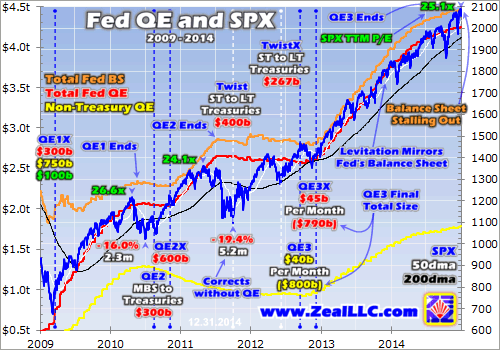This chart shows the Fed’s balance sheet is still fueling stocks
Post on: 16 Март, 2015 No Comment

AnoraMahmudova
NEW YORK (MarketWatch) — The monster rally in stocks over the past few days may be attributed to calmer oil prices or soothing comments from Federal Reserve officials, but one strategist says it’s all about the balance sheet of Janet Yellen’s Fed.
There is little doubt that the Federal Reserve’s efforts to prop up the stock market since the 2008 financial crisis through monetary stimulus measures, like buying up government bonds and other assets — better known as quantitative easing, or QE — have fueled one of the longest bull runs in history.
But those who predict a cratering of the market with the cessation of QE have, so far, been proven wrong. But perhaps for the wrong reasons.
The markets downturn Friday, with the Dow Jones Industrial Average DJIA, -0.82% showing a triple-digit decline in early morning trade, comes after two days of monster gains, which pushed U.S. stocks into positive territory for the year.
The Fed’s $4 trillion balance sheet is not shrinking. In fact, it has been quietly growing, according to Lance Roberts, strategist for STA Wealth Management. In the chart below, he estimates that the change in the Fed’s balance sheet last week was positive, helping to spur the so-called V-shaped recovery from the latest pullback in U.S. stocks.
STA Wealth Management
During her most recent press conference following the December FOMC meeting, Chairwoman Yellen said that the central bank will raise rates by adjusting its short-term target range for the federal funds rate. But shrinking the Fed’s hefty balance sheet wasn’t a talking point.
“The balance sheet might shrink relative to the total economy over time as our economy keeps growing. This will take years. But any shrinking that stems from selling or not reinvesting, will be negative for equities,” said Jonathan Golub, chief market strategist at RBC Capital Markets.
To understand the link between the Federal Reserve’s asset-buying program which ballooned its balance sheet to $4 trillion, one must understand how that money was circulated in the credit markets.
The Fed cannot buy government bonds directly from the Treasury, so it buys them from primary dealers, a category that includes certain banks, in an asset swap. In other words, the Fed does not print money, instead it lends money to banks for collateral — in this case a mixture of Treasurys and asset-backed securities such as mortgage-backed securities.
Banks swap low-yielding Treasurys and buy high-yielding bonds and deposit excess reserves back at the central bank. The profit made on this so-called carry trade, borrowing low and lending at a higher interest rate, is then used for buying stocks or other risky assets.
According to Roberts, the Fed’s QE resulted in the dollar weakening and oil prices rising. He points to a chart that shows the relationship. He also notes that the end of each of previous QE stimulus resulted in a strengthened dollar weakness in oil, which is priced in dollars.
That’s precisely the scenario investors are facing now.
StreetTalkLive.com
Market watchers, fearing that rapidly escalating inflation might upend the market, believe that the central bank’s purchase of billions of dollars of government bonds is tantamount to printing money. But they fail to understand that the same funds are deposited with the Fed but not circulated back into the economy.
Exceptionally low rates also allowed corporations to refinance their debt and borrow in capital markets in order to issue dividends and buy their own stocks. In fact, in 2014, the S&P 500 companies spent 90% of their profit on buybacks and dividends. This is an issue that has been highlighted by prominent investors like Bill Gross:
This kind of financial engineering also contributed to the rally, by reducing shares and boosting earnings. Read: Bill Gross just called an end to the bull market, again.
It is entirely reasonable to argue that stock markets are addicted to the carry trade, but it is also entirely reasonable to conclude this carry trade will continue for months or years to come, as the Fed holds on to assets on its balance sheet.
With the current global deflationary pressures, the Fed signalled that it will be patient in deciding the timing and pace of rate hikes, and future QE is not out of the question if the economy falters before the conventional tools (interest rates above zero, for example) are in place.
So, for now, don’t fight the Fed sounds like a good rule of thumb.














